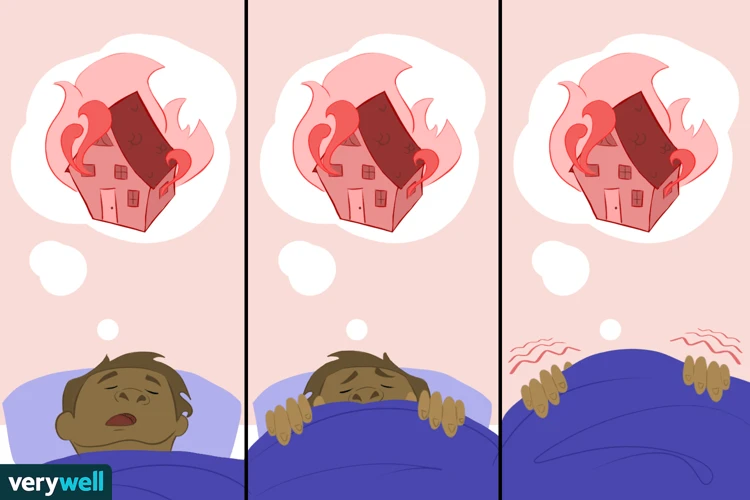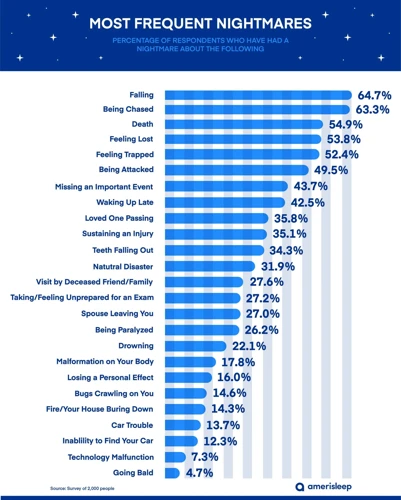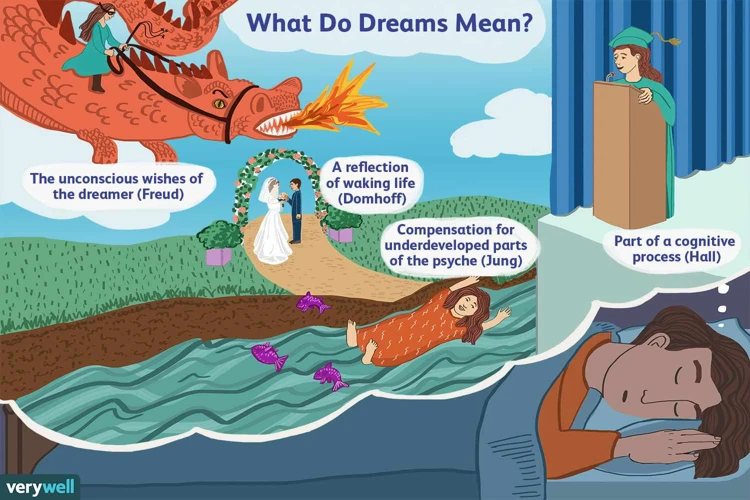Have you ever woken up from a restless night’s sleep, drenched in sweat and feeling a profound sense of unease? Bad dreams have a way of lingering long after we open our eyes, leaving us perplexed and questioning their meaning. We all experience these unsettling nocturnal journeys, but what exactly do they signify? In this article, we will explore the intricate world of bad dreams and delve into the reasons behind their occurrence. From the role of REM sleep to the impact of unresolved emotions and stress, we will uncover the various factors that contribute to the manifestation of these unsettling dreams. So, sit tight as we unravel the mysteries of the night and discover the meaning behind those eerie visions.
Why Do We Have Bad Dreams?

During the Rapid Eye Movement (REM) stage of sleep, our brain activity increases. This is when most of our dreaming occurs, including both pleasant and alarming dreams. While the exact purpose of dreaming is not fully understood, experts believe that it plays a vital role in processing emotions and memories. Bad dreams may arise as a result of this heightened brain activity during REM sleep, as our minds attempt to make sense of and process the events, emotions, and experiences of our daily lives.
Our dreams are deeply intertwined with our emotions. When we experience stress, anxiety, or unresolved emotions during our waking hours, they have a way of seeping into our dreams as well. Bad dreams can be a reflection of these unresolved feelings, serving as a means for our subconscious mind to process and cope with them. Similarly, traumatic events or past experiences that have not been fully dealt with may also surface in the form of unpleasant dreams. Understanding the link between our emotional well-being and dream content can provide valuable insights into why we have bad dreams.
The Role of REM Sleep
REM sleep, or Rapid Eye Movement sleep, plays a crucial role in the occurrence of bad dreams. During this stage of sleep, our brain activity increases, and our eyes move rapidly beneath our closed eyelids. It is in this stage that most of our vivid and memorable dreams take place. Researchers believe that REM sleep serves important functions in our cognitive and emotional processing. It is during this stage that our brains consolidate memories, process emotions, and make connections between different pieces of information. Bad dreams may occur as a result of the intense brain activity during REM sleep, as our minds attempt to process and make sense of the events, emotions, and experiences we have encountered throughout the day. This stage of sleep, although essential, can sometimes give rise to unsettling or nightmarish dreams. Understanding the role of REM sleep can shed light on why bad dreams occur and help us navigate their meaning and significance.
Unresolved Emotions and Stress
Unresolved emotions and stress can have a profound impact on the content of our dreams. When we experience intense emotions or go through stressful situations, our mind often struggles to process these feelings during waking hours. As a result, these emotions can seep into our dreams, causing them to take on a negative or distressing tone. Anxiety, fear, sadness, and anger are all emotions that can manifest in our dreams when left unresolved. Additionally, ongoing stress can contribute to a constant state of arousal, making it more likely for unsettling dreams to occur. It’s important to recognize the connection between our emotional well-being and dream content, as addressing unresolved emotions and finding healthy coping mechanisms can help alleviate the recurrence of bad dreams.
Common Themes in Bad Dreams

When it comes to bad dreams, certain themes tend to recur across different individuals. These themes often reflect our deepest fears, vulnerabilities, and anxieties. Falling is a common theme, where we feel a sense of helplessness and lack of control as we descend rapidly. Another frequent theme is being chased or attacked, symbolizing a sense of danger or threat in our waking lives. Public embarrassment is another prevalent theme, representing our fear of judgment and humiliation. Additionally, loss of control is a recurring theme, reflecting our concerns about not being able to manage situations in our lives. These common themes provide insight into the underlying fears and insecurities that may be contributing to our bad dreams. Understanding these themes can help us unravel the deeper meaning behind our unsettling nocturnal experiences.
Falling
The theme of falling is a commonly observed motif in bad dreams. It often evokes a sense of helplessness, vulnerability, and loss of control. When we dream about falling, it may symbolize a fear of failure or a feeling of being overwhelmed by life’s challenges. It can also represent a lack of stability or a fear of losing something or someone significant. These dreams often leave us with a heightened sense of anxiety and unease upon waking, reflecting our subconscious fears and concerns about the uncertainties and unpredictability of life. Understanding the symbolic meaning behind dreams of falling can offer valuable insights into our subconscious fears and help us address them in our waking lives.
Being Chased or Attacked
The theme of being chased or attacked is a common occurrence in bad dreams. These dreams can evoke a strong sense of fear, panic, and vulnerability. Being chased or attacked in dreams often represents a feeling of being pursued or threatened in our waking lives. It may signify underlying anxieties, pressures, or conflicts that we are trying to escape from or confront. These dreams may reflect a sense of powerlessness or the need to establish boundaries. Exploring the specific details and emotions associated with being chased or attacked in a dream can provide valuable insights into the underlying fears and stressors that we may need to address in our waking lives.
Public Embarrassment
Public embarrassment is a recurring theme in bad dreams for many people. These dreams often involve scenarios where individuals find themselves in embarrassing situations in front of a large audience or people they know. Common depictions of public embarrassment in dreams include being naked in public, giving a presentation with incomplete or incorrect information, or making a social faux pas. These dreams can leave individuals feeling humiliated and vulnerable, even after waking up. The exact reason for the prevalence of this theme is not fully understood, but it may be connected to our innate fear of judgment and rejection. Public embarrassment dreams can be a manifestation of our subconscious anxieties about being judged by others or fear of making mistakes that could impact our social standing or reputation. It is important to remember that these dreams are not indicative of personal shortcomings but rather a reflection of common insecurities shared by many.
Loss of Control
A common theme in bad dreams is the loss of control. These dreams can manifest in various ways, such as being trapped in a confined space, being unable to move or speak, or feeling powerless in a dangerous situation. This theme often reflects our underlying fears and anxieties about feeling helpless or lacking control in our waking lives. It may stem from situations where we feel overwhelmed or unable to influence the outcomes. These dreams serve as a symbolic representation of our concerns about not being able to steer our lives in the desired direction. Exploring the meaning behind these dreams can help us gain a deeper understanding of the underlying fears and desires that may be influencing our waking actions and choices.
Interpreting the Meaning Behind Bad Dreams

When it comes to interpreting the meaning behind bad dreams, it’s important to consider both personal context and symbolic representations. The personal context involves examining the specific events, emotions, and experiences that have been troubling us in our waking lives. It requires introspection and self-reflection to identify any connections between our reality and the content of our dreams. For example, if someone has been feeling overwhelmed at work, a recurring bad dream of being chased or attacked may symbolize their struggle to escape from mounting pressures.
Symbolic representations play a significant role in dream interpretation as well. Dreams often rely on symbols and metaphors to convey messages and emotions. Analyzing the symbols present in a bad dream can provide insights into our subconscious fears, desires, and conflicts. However, it’s crucial to remember that dream symbolism is highly individualized and can vary from person to person. While some common symbols exist, their interpretation should be tailored to the dreamer’s unique experiences and emotions.
By considering both personal context and symbolism, we can begin to unravel the hidden meanings behind our bad dreams. It is through this process of reflection and interpretation that we can gain a deeper understanding of ourselves and potentially find ways to address any underlying issues that may be contributing to our unsettling dream experiences.
Personal Context
To truly understand the meaning behind our bad dreams, we must consider our personal context. Dreams are highly subjective and influenced by our unique experiences, beliefs, and memories. Personal context plays a significant role in shaping the symbolism and themes that appear in our dreams. For example, falling in a dream may have different interpretations for different individuals. It could represent a fear of failure, a loss of control, or even a sense of letting go. Analyzing the personal context of our dreams helps us unravel the subconscious messages that our minds are trying to convey. By reflecting on our emotions, experiences, and current situations, we can gain greater insight into the significance of our bad dreams and how they are connected to our waking lives.
Symbolic Representations
When it comes to interpreting the meaning behind bad dreams, one approach is to consider the symbolic representations that may be present in the dream. Dreams often utilize symbols and metaphors to convey messages and emotions. For example, falling in a dream could represent a loss of control or a fear of failure in waking life. Being chased or attacked may symbolize a sense of vulnerability or pressure. Public embarrassment could indicate feelings of inadequacy or fear of judgment. Loss of control in a dream might reflect a person’s struggle with letting go or feeling overwhelmed. By identifying and analyzing these symbolic representations, we can gain a deeper understanding of the underlying emotions and issues that our bad dreams may be addressing.
Psychological Perspectives
Psychological perspectives offer a deeper understanding of the meaning behind bad dreams. They suggest that our dreams are a manifestation of our unconscious fears, anxieties, and desires. These dreams can serve as a window into our deepest thoughts and emotions, allowing us to gain insight into our psychological well-being. Unconscious fears and anxieties that we may not even be aware of during our waking hours can find their way into our dreams, presenting themselves in scenarios that can be disturbing or unsettling. Additionally, dreams can provide a platform for our subconscious mind to process and make sense of complex emotions or situations that we may not be consciously aware of. This perspective highlights the intricate and profound nature of our dreams, as they can reveal hidden depths of our psyche and offer important psychological insights.
Unconscious Fears and Anxieties
Unconscious fears and anxieties can heavily influence the content of our bad dreams. These fears and anxieties can stem from a variety of sources, such as childhood experiences, traumatic events, or deeply ingrained beliefs. Our subconscious mind often uses dreams as a way to bring these fears and anxieties to the surface, allowing us to confront and process them.
Some common themes that may arise from unconscious fears and anxieties include being trapped, falling, or being chased or attacked. These dreams can feel incredibly vivid and intense, as they tap into our deepest fears and insecurities. For example, dreams of being chased may be symbolic of a fear of confrontation or a sense of being overwhelmed by responsibilities. Similarly, dreams of being trapped can represent feelings of being stuck or hindered in some aspect of our lives.
It’s important to remember that the meaning behind these dreams is highly individual and can vary greatly from person to person. Exploring these unconscious fears and anxieties with a therapist or through self-reflection can provide valuable insights into their origins and how they may be impacting our everyday lives.
Subconscious Processing
Dreams provide a unique window into our subconscious mind, allowing us to process thoughts, emotions, and memories that may not be immediately accessible to our conscious awareness. Subconscious processing plays a significant role in the content of our dreams. Our minds have a remarkable ability to analyze and make sense of complex information, even when we are not consciously aware of it. Through dreams, our subconscious works to make connections, draw conclusions, and create narratives that can help us make sense of our experiences and emotions. It is during this process of subconscious processing that bad dreams can arise, as our minds grapple with unresolved fears, anxieties, and conflicts that we may not even be aware of while awake. By paying attention to the symbols and themes that appear in our dreams, we can gain insight into our subconscious processing and work towards understanding and resolving underlying issues that may be contributing to the presence of bad dreams.
Conclusion
In conclusion, bad dreams can be unsettling and leave us pondering their meaning. While the exact interpretation of these dreams may vary from person to person, understanding the underlying factors that contribute to their occurrence can offer valuable insights. Dreams provide a window into our emotions, unresolved stress, and subconscious processing. By exploring the common themes in bad dreams and examining personal context and symbolic representations, we can gain a deeper understanding of ourselves and our fears. It’s important to approach bad dreams with curiosity and an open mind, as they often hold hidden messages and serve as a means for self-reflection and growth. So, the next time you find yourself waking up from a particularly haunting dream, take a moment to ponder its meaning and uncover the possible lessons it may hold.
Frequently Asked Questions
1. Can bad dreams have a physical impact on our bodies?
Yes, bad dreams can elicit physical responses such as rapid heart rate, increased blood pressure, and sweating. These physiological reactions are known as “fight or flight” responses triggered by the intense emotions experienced during the dream.
2. Are recurring bad dreams a cause for concern?
Recurring bad dreams can be distressing, but they are usually a sign that our minds are trying to highlight unresolved issues or emotions. It may be helpful to explore these recurring themes and seek support if needed to address underlying concerns.
3. Can eating certain foods before bed influence our dreams?
While there is no definitive scientific evidence linking specific foods to dream content, certain substances like caffeine and alcohol can affect sleep quality and potentially influence the content of our dreams. It’s best to maintain a balanced diet and avoid consuming stimulating substances close to bedtime.
4. Do children experience more bad dreams than adults?
Research suggests that children tend to experience more frequent and intense dreams, including bad dreams, compared to adults. This is thought to be due to the rapid development of their imagination and emotional processing abilities.
5. Can medication or sleep disorders contribute to bad dreams?
Yes, certain medications, including antidepressants, can influence dream patterns and increase the likelihood of experiencing vivid or disturbing dreams. Additionally, sleep disorders such as sleep apnea or insomnia can disrupt the sleep cycle, potentially leading to more frequent occurrence of bad dreams.
6. How can keeping a dream journal help in understanding bad dreams?
Keeping a dream journal can help you recognize patterns or recurring themes in your dreams. It enables you to reflect on your emotions, events, or stressors that may be influencing your dream content. Over time, this practice can provide insights into the meaning behind your bad dreams.
7. Is it possible to control or change the outcome of a bad dream?
Lucid dreaming techniques, such as reality checks and setting intentions before sleep, may increase the likelihood of realizing that you are in a dream and having some control over the dream’s direction. However, complete control over dream content is not guaranteed and may take practice.
8. Can talking about our bad dreams with others be helpful?
Sharing your bad dreams with a trusted friend, family member, or therapist can provide an opportunity to verbalize and process the emotions associated with the dream. It can offer a fresh perspective or insights that may help alleviate fears or anxieties surrounding the dream.
9. Do cultural or personal beliefs impact the interpretation of bad dreams?
Yes, cultural and personal beliefs can significantly influence how we interpret the meaning behind bad dreams. Symbols, themes, and emotions may hold different significance based on individual experiences and cultural contexts. It’s important to consider these factors when attempting to interpret the meaning of a bad dream.
10. Can practicing relaxation techniques before bed reduce the occurrence of bad dreams?
Engaging in relaxation techniques such as meditation, deep breathing exercises, or gentle stretching can help reduce overall stress levels, which may indirectly decrease the likelihood of experiencing bad dreams. Creating a calming bedtime routine can promote more restful and peaceful sleep.


